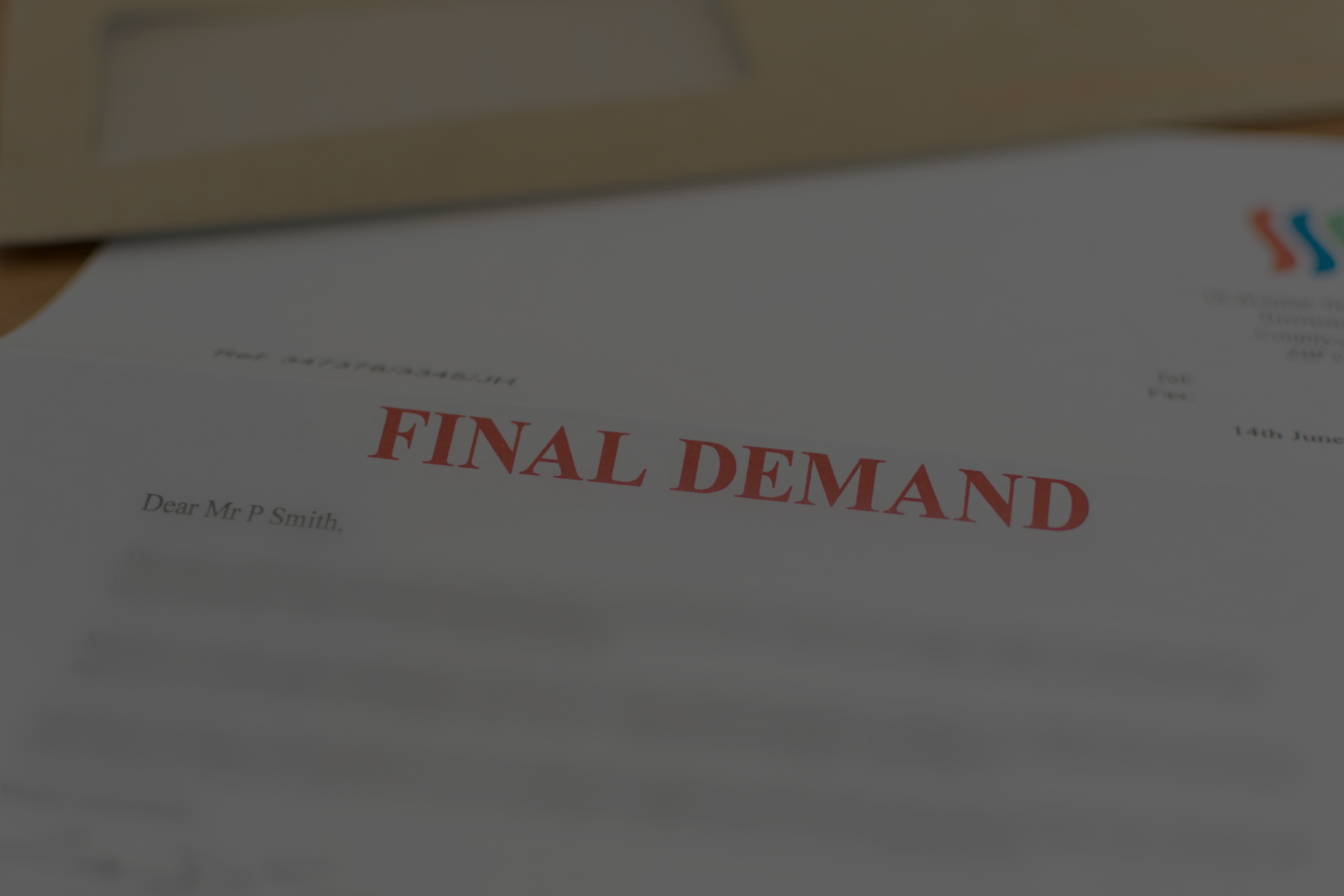Insolvency and Debt Recovery

Insolvency and Debt Recovery Lawyers
Insolvency and debt recovery matters can be incredibly stressful, whether you’re a business chasing up debts, or an individual owed money.
Here at Ivy Law Group, our dedicated team of commercial lawyers are here to assist in getting the best outcome possible for you, whether you are a Creditor or a Debtor.
We have experience across all areas of insolvency and debt recovery and can advise on and draft the relevant documents for individuals, businesses and companies in relation to the following:
Letter of Demand
A letter of demand is a formal request for payment issued to the person or company that owes you money. It is typically the first step in the process to retrieve monies owed to you, as it can save you time and money if the issuing of the Letter of Demand results in payment of the money owed to you.
In some instances, you may have an ongoing relationship with the person or company that owes you money and having a Letter of Demand that addresses your specific situation may result in the desired effect of getting paid and resolving the matter.
At Ivy Law Group, we can assist with advising you and drafting a Letter of Demand that is tailored to your needs.
Statements of Claim
A Statement of Claim can be issued if the Letter of Demand has not resulted in payment. It s the first step in the Court process. A Statement of Claim is filed by the person or a company owed money (the Plaintiff) and puts into motion, steps that need to be taken to retrieve monies owed.
Although a Statement of Claim can be issued in various situations, the most common is when the Plaintiff will claim money owed to it by a debtor (person or a company) (the Defendant). This is usually as a result of a written agreement between the Plaintiff and the Defendant, where goods and / or services have been supplied, invoices issued, and which remain unpaid.
What is the process for issuing a Statement of Claim?
In New South Wales, the process for commencing proceedings by way of a Statement of Claim is predominately governed by the Uniform Civil Procedure Rules 2005.
Proceedings can be commenced in either the Local Court, District Court of Supreme Court depending on what amount is owed and whether there is any other relief being sough in the Statement of Claim other than for monies to be paid to the Plaintiff.
In most situations, the Defendant will have 28 days after service of the Statement of Claim to pay the amount claimed (and any interest and costs claimed) or file a Defence. The Defence will set out the basis of why the amount claimed is not owed. The Defendant may also file a Cross-Claim seeking that money is owed to it from either the Plaintiff or a third party. Once a Defence is filed, a matter will be listed for a first court date.
The time frame between filing the Statement of Claim and proceeding to a Final Hearing can exceed 12 months.
If a Defence is not filed within 28 days of the Statement of Claim being served on the Defendant, the Plaintiff can apply for what is called Default Judgment. This is an order made by the Court that the Defendant must pay the Plaintiff a certain sum of money (“Judgment Debt”) and it is enforceable without the matter having to be heard in Court. Judgment will be made on the documents filed, provided the documents that are filed have been completed correctly.
Once a Judgment has been entered, the Plaintiff will have options to enforce payment of the judgment debt including:
- Garnishee Order for Debts or Wages;
- Writ for goods or property;
- Examination Order; or
- Bankruptcy Notice.
Deciding what enforcement action to take, will depend upon the circumstances of the matter. Ivy Law Group’s team of commercial lawyers can assist you with this decision, including advising on the advantages and disadvantages of each method.
There are many steps that are required to be taken between the filing of either the Statement of Claim or Defence and a Final Hearing. It is for this reason that you may require legal advice on filing a Statement of Claim or responding to it and preparation of the documents and appearing in Court.
Bankruptcy notices and Creditor’s petitions
A Creditor can issue a Bankruptcy Notice against the Judgment Debtor, for a debt resulting from a final Judgment or Order that is in the amount of $10,000 or more. The Bankruptcy Notice is lodged with the Australian Financial Security Authority and once issued by the Official Receiver, the Creditor will need to serve the document on the Debtor in accordance with the requirements for service.
Once served, the Debtor will have 21 days to comply with the Bankruptcy Notice. If the Debtor fails to comply within that time, the Debtor commits an act of bankruptcy pursuant to s40(1)(g) of the Bankruptcy Act 1966.
Within 6 months of the Act of Bankruptcy being committed, a Creditor may apply to either the Federal Court of Australia or the Federal Circuit Court of Australia by filing a Creditor’s Petition and other required documents to seek that the Court make a Sequestration Order. In other words, that the Debtor be made Bankrupt.
If a Sequestration Order is made, a Trustee is appointed to administer the Bankrupt Estate. This means that a Creditor will not necessarily receive payment at all or in full. What amount a Creditor will be paid will depend on what assets, if any, are in the Bankrupt Estate and what priority the Creditor ranks as. There should be careful consideration given when applying for a Bankruptcy Notice.
If you wish to serve a Bankruptcy Notice or if you have been served with a Bankruptcy Notice, get in touch with our commercial law team today for tailored legal advice.
Creditors’ Statutory Demand
This is an effective tool used by Creditors to recover debts owed to them by Debtors.
A Statutory Demand is issued by a Creditor under s459E of the Corporations Act 2001, on a Debtor if money is owed to the Creditor in relation to a single debt of at least $4,000, or two or more debts totalling at least $4,000.
The Debtor will have 21 days to comply with the Statutory Demand, after which a Creditor may proceed to make an application to the Supreme Court of New South Wales or the Federal Court of Australia to commence winding-up proceedings against the Debtor.
Our experienced team of commercial lawyers can assist with issuing a Statutory Demand on your behalf to recover monies owed, or provide tailored legal advice if you have been issued one.
Winding-up applications
A winding-up application can be made by a Creditor in either the Supreme Court of New South Wales or the Federal Court of Australia under s459A and s459P of the Corporations Act 2001 on the presumption of insolvency given the Debtor has not complied with the Statutory Demand.
An application to wind up a company in insolvency must be done within three months of the date that a company is presumed to be insolvent. If you require advice on issuing a wind-up application, contact our commercial lawyers on 02 9262 4003 today.
Deeds of Company Arrangement
A Deed of Company Arrangement is an important agreement that is used to define the specific legal requirements that are binding between the company and its creditors. It can be put in place when a company is facing the danger of becoming insolvent or has entered voluntary administration. This arrangement is a binding agreement between the company and its creditors outlining how the assets and the company will be dealt with.
For a business, a Deed of Company Arrangement may assist the company to continue to operate, and potentially avoid liquidation. For a Creditor, a Deed of Company Arrangement allows you to cooperate with fellow Creditors to ensure that the best outcome is reached.
Voluntary and involuntary administration
This can occur due to a variety of reasons, but there are avenues available that may assist a company to avoid going into liquidation. Our team of experienced commercial law can assist in determining the best possible outcome for you and your business, dependant on your individual circumstances.
When a company goes into Voluntary Administration there are three possible outcomes:
- The company is deemed viable, and the Directors receive control of the company;
- A Deed of Company Arrangement is designed, stating the company’s intentions going forward; or
- The company is deemed not viable and is wound-up and put into liquidation.
When a company is forced into involuntary administration, it usually follows from the Creditors making a winding-up application. In the meantime, until a company is wound up, the Creditor chooses an administrator, which the Court then appoints. The administrator will take steps to assess the assets of the company and until a liquidator has been appointed.
Court applications for the appointment of receivers
This type of application is made pursuant to an application to the court where the receiver will be appointed to preserve and maximise the return of a debt to certain creditor(s). A receiver must be an independent and qualified individual, to ensure that they will act in the best interests of the creditor. Unlike a liquidator or voluntary administrator, receivers act only in the interest of certain creditors.
How can Ivy Law Help?
If you would like legal advice or guidance on any insolvency or debt recovery related matters, our experienced Sydney commercial lawyers are here to help. Give us a call on 02 9262 4003 to discuss your needs or submit an online enquiry to get started.





